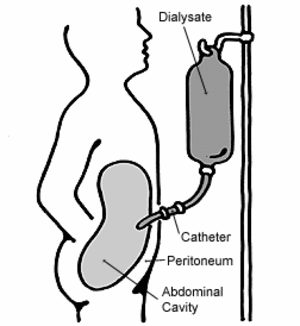People who are suffering from kidney failure often need dialysis treatment. One type of dialysis treatment is called peritoneal dialysis. Before discussing how peritoneal dialysis works, let’s first explain what your kidneys do and why you would need dialysis treatment.
Kidney function and the need for kidney dialysis
The main function of our kidneys is to remove metabolic waste from our blood. The waste is then eliminated from our bodies through urination. Each kidney has approximately one million filters or nephrons to help get rid of this waste. Kidney failure happens when a person does not have enough working nephrons to perform this task. When your kidneys are no longer able to do their job and filter metabolic waste from your blood, kidney dialysis must be performed instead. You can say dialysis is like an artificial kidney.
How does peritoneal dialysis work?
You may be familiar with hemodialysis . That’s when blood is removed from the patient, goes through a dialysis machine to remove the waste, and the clean blood is returned back to the patient. Well, unlike hemodialysis, peritoneal dialysis uses the lining of the patient’s abdomen (called the peritoneum) as its dialysis machine. First, the patient has tube inserted into his abdomen. Then a sterile solution (called a dialysate) is instilled into the person’s abdomen through this tube. While the solution is inside the patient, it absorbs the metabolic waste from the blood vessels around the abdomen. After about 20 to 30 minutes, the solution and waste are drained from the abdomen into a bag. The entire process usually takes under an hour and may be repeated several times a day.
What advantages and disadvantages peritoneal dialysis?
Unlike hemodialysis, peritoneal dialysis does not involve being hooked up to a huge machine for several hours, three to four times a week. The equipment used is inexpensive and compact so the patient can be more mobile while the dialysis is taking place. So peritoneal dialysis has the advantage of being more convenient for the patient.
Disadvantages of peritoneal dialysis include the time for reaching the procedure’s therapeutic effect. What can be accomplished metabolically with hemodialysis in just a few hours may take up to 36 hours using peritoneal dialysis. Peritoneal dialysis also runs a high risk of causing peritonitis, an inflammation of the peritoneum and a potentially serious complication.
Note: This article is for informational purposes only. If you have kidney failure and require dialysis, speak with your doctor about which treatment is best for you.
Sources:
Lemone, Pricilla and Burke, Karen (2008). Clinical Handbook On Medical Surgical Nursing (4th ed). Upper Saddle River, NJ: Prentice Hall, pp 769, 899
National Kidney and Urologic Diseases Information Clearing House, Treatment Methods for Kidney Failure: Peritoneal Dialysis, May 2006. Retrieved on January 31, 2011.
Sole, Mary Lou, Klein Deborah G., Moseley, Marthe J.(2005), Introduction To Critical Care Nursing (5 th ed).St Louis: Elsevier, pp 483





